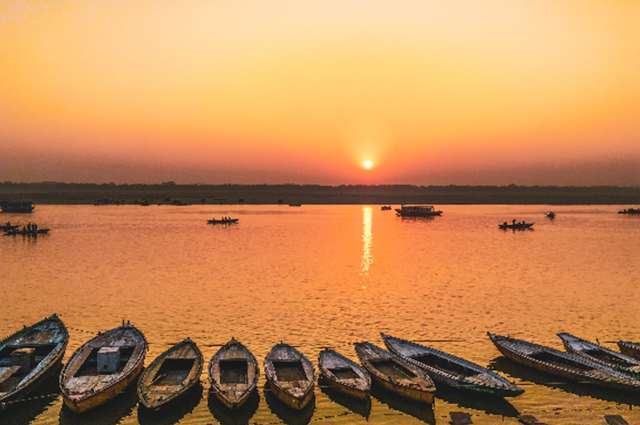
In Chapter 10, verse 31 of the holy Bhagawad Gita, Lord Krishna says,
पवन: पवतामस्मि राम: शस्त्रभृतामहम् |
झषाणां मकरश्चास्मि स्रोतसामस्मि जाह्नवी |
Here he implies that of all the purifiers, he is the wind, of the wielders of weapons he is Lord Ram. Of aquatic creatures, he is the crocodile, and of flowing rivers, he is the Ganges.
Legends have it that King Bhagirathi, through his long and devout prayers, made the river descend from heaven to the earth for the redemption of his departed lineages. From time immemorial, the Ganga has been esteemed as a goddess and her purity bathes the sins of believers and eases the dead on their pathway towards heaven.
The Ganges River commences in the Himalayas, approximately 480 km north of Delhi and 8 km south of the India-Tibet border where it surfaces from 'Gaumukh' (the Cow’s Mouth), an ice cave and is identified as the Bhagirathi.
Despite all the faith bestowed upon the river, we, Indians are not able to keep pace with the purity of the river. The Ganges water is acknowledged as "holy" and is recognized for its "therapeutic" attributes.
In the 1800s, the British sailors insisted on collecting water from the Ganges instead of the Thames for their long journeys because, unlike the latter, it's water would not putrefy for days.
The river also stands as a substantial water source, functioning as the source of livelihood for Indians since primeval times.
India is a hub of spiritualism that western travellers are always seeking. In the course of centuries, Central Asian dominions, European traders, the British Kingdom, and the Indian princely states, all have forged the uniqueness and ecology of the Ganga.
Muhammad Akbar, the third Mughal emperor of India called the Ganges “the water of immortality” and asserted on distributing it at his court. In 1615, Nicholas Withington, one of the initial British travellers in India, penned in one of his writings that water from the Ganges would never turn stale or become a breeding place of worms or vermin even if it is kept for a long time.
In 1896, a British bacteriologist discovered cholera causing bacteria “Vibrio Cholerae” died within hours when put into the Ganges water.
A mysterious sound, known as “Barisal Guns” has been discovered in the regions of the Ganga delta. An interesting fact about this sound is that it bears a resemblance to a sonic boom of the supersonic jet, an invention that came into existence much later.
The water extracted from the upper domains of Ganga not only prevent mosquito breeding in its own water but also to other water sources if added to it.
The myth insists that the river possesses a self-cleansing formula, sometimes attributed to sulphur springs, or exposed levels of natural radioactivity in the Himalayan headwaters, or to the occurrence of bacteriophages like Escherichia, Salmonella, Shigella etc, viruses that can kill bacteria. Additionally, phage therapy, a natural substitute for antibiotics can use its water due to these bacteriophages found in it.
However, one of the most intriguing things about the Ganges is that despite all the scientific findings, the paradox of purity and contamination cannot be fully explained.
When the river flows downstream, it encounters extremely inhabited cities before assimilating into the Bay of Bengal. Starting from the origin to its merger into the sea, the texture of its water transforms from crystal clear to sewage-infiltrated sludge but still manage to preserve high quantities of dissolved oxygen notwithstanding. This is the reason that despite adulteration, the Ganges is still being considered holy.
Many missions have been taken up for the efficacious reduction of pollution, rejuvenation of the Ganges and its conservation. The budget presented in the Parliament on July 10th in the year 2014, Arun Jaitley, the Union Finance Minister declared a cohesive plan for the development of the Ganges named as the 'Namami Gange' and allotted around ₹2037 Crores for this drive.
The main pillars of the ‘Namami Gange’ Programme included River-Front Development, afforestation, general consciousness among the public regarding Ganges, bio-diversity, surface cleaning etc.
Recently in September 2021, an MoU(Memorandum of Understanding) has been signed between the NMCG and South Asian Institute for Advanced Research and Development to thrive capacity building on the management of the Ganges basin and Geospatial technology. The enterprise will open a window for young minds to work on river basin management and recommend key points for river management built on Geospatial technology.
The operation is divided into different levels of action which includes activities for an instantaneous visible impact, then within 5 years of the time frame and long terms goals to be achieved spanning for 10 years.
The viewpoint is reinforced by the advantages that the scheme is to offer in terms of employment opportunities, enhanced lifestyle and health paybacks to the gigantic population that is reliant on the river.
